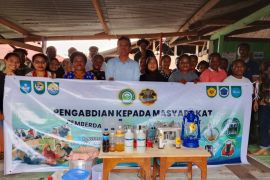It was once a popular tourist attraction until the early 2000, but the area still offers unique sights of water buffalo farming in the 19 thousand hectares of swamp area.
It takes some two hours by car to reach the sub-district from Amuntai, the capital city of North Hulu Sungai District. Some 89 percent of the district is a monotonous swamp area.
The closer to the sub-district, the less prominent do the houses become. Only swamp covered by wild grass and water hyacinth can be spotted on both sides of the road.
To reach the swamp buffalo farming site, visitors have to board a boat from a small dock located near the Danau Panggang market. Local residents rent single- and double-engine boats for visitors to reach the farm.
A local resident and a skipper for one of the boats, Firmansyah knew precisely where to locate the buffaloes in such a huge swamp area.
As rainy days continue, visitors only had to hitch a boat ride for some 20 minutes to get to the area where the buffaloes graze and bathe.
In the initial five minutes, one could spot stilt houses and children bathing. The stilt houses are connected with a long wooden and narrow path that enable them to reach dry land, by foot or motorcycle.
We can still spot some floating houses, the traditional housing in South Kalimantan, kept afloat by logs that uphold them under the water. Apparently, some were already abandoned by the owners.
Firmansyah drove his boat faster once he reached a wider path, although in some spots he had to maneuver to avoid thick mats of water hyacinth afloat in the middle of the pathway.
Finally, he found a "kalang," an elevated roofless platform where the buffaloes spent the night after swimming and wallowing in the swamp. Farmers has set up a wooden bridge for the buffaloes to access the water.
The last buffalo had just climbed to the platform when Firmansyah and his guests arrived.
"We have to take them up here faster, as the water level has risen," the owner of the buffaloes Ahmad Jawad stated.
It was just 4 p.m. local time, and the sun had yet to set. However, dark clouds and lightning had compelled Jawad to step up his pace to escort all his buffaloes up to the platform.
Swamp buffaloes spend their day in the water eating grass that float in the swamp. As the sun rises, they jump down to the water and swim in search of grass around the platform. When the sun sets, they return to the "kalang" and spend the night there.

"The water level is still rising, and it will be too deep for the buffalo," he stated.
The water in the swamp would rise to its highest level of above three meters in April, and it would slowly decline and almost go dry during the August-October period.
However, swamp buffaloes are good swimmers.
When the water level is too high and the grass can hardly be found in the nearest area, the water buffaloes can swim as far as eight kilometers in search of feed in a shallower area. Farmers will only have to herd them to the right location.
On the other hand, when the water level is too low, farmers will herd them to the "river," a deeper area that usually serves as a pathway for boats, as swamp buffaloes need to wallow.
Currently, 16 farmers engage in farming in the swamp, with each tending to nearly 100 buffaloes.
Jawad only has 24 buffaloes, with the heaviest weighing some 100 kilograms, that can be sold at Rp25 million.
He has built a hut beside the elevated platform to watch over the buffaloes and protect them from thieves.
An important tip for visitors to Danau Panggang is that they should be heedful of the weather while visiting the swamp area during rainy days.
Strong winds can distort the original pathway of boats, as wild grass and hyacinth get scattered by the wind.
Here, Firmansyah demonstrates his skill. After almost an hour of driving through the thin grass, taking the wrong direction and then turning back, he finally found the "main street", the original wider pathway that we had taken earlier and reached the dock in the presence of torrential rain.
Related news: A closer look at Dayak Meratus' thanksgiving ritual
Related news: Sabang's Zero Kilometer Monument named unique tourism destination
Editor: Gusti Nur Cahya Aryani
Copyright © ANTARA 2020












